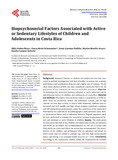Mostrar el registro sencillo del ítem
Biopsychosocial Factors Associated with Active or Sedentary Lifestyles of Children and Adolescents in Costa Rica
| dc.creator | Núñez Rivas, Hilda Patricia | |
| dc.creator | Holst Schumacher, Ileana | |
| dc.creator | Guzmán Padilla, Sonia | |
| dc.creator | Roselló Araya, Marlen | |
| dc.creator | Campos Saborío, Natalia | |
| dc.date.accessioned | 2021-10-29T19:51:19Z | |
| dc.date.available | 2021-10-29T19:51:19Z | |
| dc.date.issued | 2020 | |
| dc.identifier.citation | https://www.scirp.org/journal/paperinformation.aspx?paperid=104376 | |
| dc.identifier.issn | 2164-0408 | |
| dc.identifier.uri | https://hdl.handle.net/10669/84868 | |
| dc.description.abstract | Background: Sedentary lifestyle in children and adolescents has been associated in multiple investigations with lack of healthy recreation, low academic performance and socialization, drug use and a higher rate of violence. On the other hand, physical activity has been considered a protective factor for the prevention of non-communicable diseases and health promotion. Objective: To determine the association between sedentary or active behaviors and biopsychosocial factors of children and adolescents of Costa Rica. Materials and Methods: Descriptive cross-sectional study in a population of 2284 students from 64 educational centers (40 elementary schools and 24 high schools) in Costa Rica in 2016. A total of 1063 elementary students were interviewed and 1221 middle and high school students completed a validated and self-administered questionnaire under the supervision of the researchers. Information was collected on sociodemographic, anthropometric data, dietary, psychosocial factors and on sedentary behavior. Logistic regression models were performed to examine the association between biopsychosocial factors and sedentary or active lifestyles in children. Results: The study points out that more than half of the children and adolescents (52.0%) are sedentary and 64.0% do not follow the recommendations for the use of screen time. Only 44.0% are active and follow the screen time recommended. The characteristics of the children and adolescents who are sedentary and spend too much screen time are related to younger age, male sex, high socioeconomic status, and belong to an extended family structure (p < 0.05). Conclusions: According to the multivariate models tested, the biopsychosocial variables statistically associated with sedentary lifestyles were age, being female, school violence, not having parental support, living in unsafe spaces and without recreational areas, belonging to the “Emo” subculture, not having a healthy diet, belonging to an extended family and quantity of relatives who are not used to do physical activity. This evidence should be considered for the design of comprehensive interventions that seek to reverse sedentary behaviors in children and adolescents. | es_ES |
| dc.language.iso | eng | es_ES |
| dc.source | Advances in Physical Education, vol.10(4), pp.476-491 | es_ES |
| dc.subject | Physical activity | es_ES |
| dc.subject | Sedentary lifestyle | es_ES |
| dc.subject | Psychosocial factors | es_ES |
| dc.subject | Children and adolescents | es_ES |
| dc.subject | Costa Rica | es_ES |
| dc.title | Biopsychosocial Factors Associated with Active or Sedentary Lifestyles of Children and Adolescents in Costa Rica | es_ES |
| dc.type | artículo original | |
| dc.identifier.doi | 10.4236/ape.2020.104037 | |
| dc.description.procedence | UCR::Vicerrectoría de Investigación::Unidades de Investigación::Ciencias de la Salud::Centro de Investigación en Hematología y Trastornos Afines (CIHATA) | es_ES |
Ficheros en el ítem
Este ítem aparece en la(s) siguiente(s) colección(ones)
-
Microbiología [1171]


